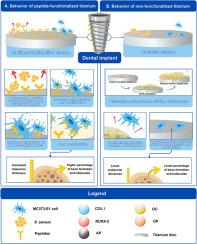Functionalization of titanium surfaces with bioactive and antimicrobial peptide coatings - A systematic review and meta-analysis
IF 5.5
2区 医学
Q1 DENTISTRY, ORAL SURGERY & MEDICINE
引用次数: 0
Abstract
Background
This systematic aimed to answer: "How do peptide coatings functionalize titanium (Ti) surfaces?". The question was structured according to the PICOS strategy, PRISMA guidelines were followed and the review was registered in the Open Science Framework.
Methods
A personalized search strategy was applied to Embase, Lilacs, PubMed/MEDLINE, Science Direct, Scopus, Web of Science Google Scholar and ProQuest databases. Included studies were in vitro, in vivo, or ex vivo experiments investigating the antimicrobial and osteogenic effects of peptide-functionalized Ti surfaces against Sthaphylococcus aureus and/or MC3T3-E1 cells. Excluded papers were clinical studies, reviews, studies lacking Ti surfaces or controls, those not using S. aureus or MC3T3-E1 cells, or involving non-murine models or peptide coatings combined with other agents. The risk of bias was assessed using RoBDEMAT for in vitro and Syrcle for in vivo studies. Meta-analysis was performed using inverse variance method under a random-effects model, 95 % confidence intervals (95 % CI), p-values, and heterogeneity index (I2).
Results
A total of 1731 potential studies were identified, 728 were screened by title and abstract, 52 were selected for full reading, 43 were included in this systematic review and all studies showed high risk of bias. In vitro, peptide-functionalized Ti surfaces significantly reduced S. aureus adhesion and proliferation (effect size: -8.10, 95 % CI [-13.33 to -2.86], p = 0.002) and showed slightly higher cytotoxicity (0.67 [0.37–0.98], p < 0.001) for MC3T3-E1 cells, but enhanced bone mineralization (4.63 [2.44–6.81], p < 0.001) and expression of pro-osteogenic genes (2.30 [1.89–2.71], p < 0.001). In vivo, functionalized implants led to greater new bone formation (7.81 [5.44–10.18], p < 0.001), trabecular number (11.22 [3.78–18.66], p = 0.003), and thickness (6.38 [3.05–9.71], p = 0.0002).
Discussion
Peptide coating of Ti surfaces for dental application can optimize implant performance, reduce infection and failure rates, and contribute to the development of safer and more effective therapies in oral rehabilitation. Therefore, this systematic review answered its question, as Ti coatings with peptides show antimicrobial and osteogenic activity as a surface functionalization mechanism.

具有生物活性和抗菌肽涂层的钛表面功能化-系统综述和荟萃分析。
背景:该系统旨在回答:“肽涂层如何功能化钛(Ti)表面?”。问题是根据PICOS策略构建的,遵循PRISMA指南,审查在开放科学框架中注册。方法:对Embase、Lilacs、PubMed/MEDLINE、Science Direct、Scopus、Web of Science谷歌Scholar和ProQuest数据库采用个性化检索策略。包括体外、体内或离体实验,研究肽功能化Ti表面对金黄色葡萄球菌和/或MC3T3-E1细胞的抗菌和成骨作用。排除的论文包括临床研究、综述、缺乏Ti表面或对照的研究、未使用金黄色葡萄球菌或MC3T3-E1细胞的研究、未涉及非小鼠模型或肽包膜与其他药物联合的研究。在体外研究中使用RoBDEMAT评估偏倚风险,在体内研究中使用cycle评估偏倚风险。meta分析采用逆方差法,采用随机效应模型、95%置信区间(95% CI)、p值和异质性指数(I2)。结果:共筛选到1731项潜在研究,其中728项通过标题和摘要筛选,52项入选全文阅读,43项纳入本系统评价,所有研究均为高偏倚风险。在体外,肽功能化的Ti表面显著降低了金黄色球菌的粘附和增殖(效应值:-8.10,95% CI [-13.33 ~ -2.86], p = 0.002),对mc3p3 - e1细胞的细胞毒性(0.67 [0.37 ~ 0.98],p < 0.001)略有提高,但增强了骨矿化(4.63 [2.44 ~ 6.81],p < 0.001)和促成骨基因的表达(2.30 [1.89 ~ 2.71],p < 0.001)。在体内,功能化种植体导致更多的新骨形成(7.81 [5.44-10.18],p < 0.001),小梁数(11.22 [3.78-18.66],p = 0.003)和厚度(6.38 [3.05-9.71],p = 0.0002)。讨论:牙用钛表面肽包覆可以优化种植体性能,降低感染和失败率,有助于开发更安全、更有效的口腔康复治疗方法。因此,这篇系统综述回答了这个问题,因为带有肽的钛涂层显示出抗菌和成骨活性作为表面功能化机制。
本文章由计算机程序翻译,如有差异,请以英文原文为准。
求助全文
约1分钟内获得全文
求助全文
来源期刊

Journal of dentistry
医学-牙科与口腔外科
CiteScore
7.30
自引率
11.40%
发文量
349
审稿时长
35 days
期刊介绍:
The Journal of Dentistry has an open access mirror journal The Journal of Dentistry: X, sharing the same aims and scope, editorial team, submission system and rigorous peer review.
The Journal of Dentistry is the leading international dental journal within the field of Restorative Dentistry. Placing an emphasis on publishing novel and high-quality research papers, the Journal aims to influence the practice of dentistry at clinician, research, industry and policy-maker level on an international basis.
Topics covered include the management of dental disease, periodontology, endodontology, operative dentistry, fixed and removable prosthodontics, dental biomaterials science, long-term clinical trials including epidemiology and oral health, technology transfer of new scientific instrumentation or procedures, as well as clinically relevant oral biology and translational research.
The Journal of Dentistry will publish original scientific research papers including short communications. It is also interested in publishing review articles and leaders in themed areas which will be linked to new scientific research. Conference proceedings are also welcome and expressions of interest should be communicated to the Editor.
 求助内容:
求助内容: 应助结果提醒方式:
应助结果提醒方式:


